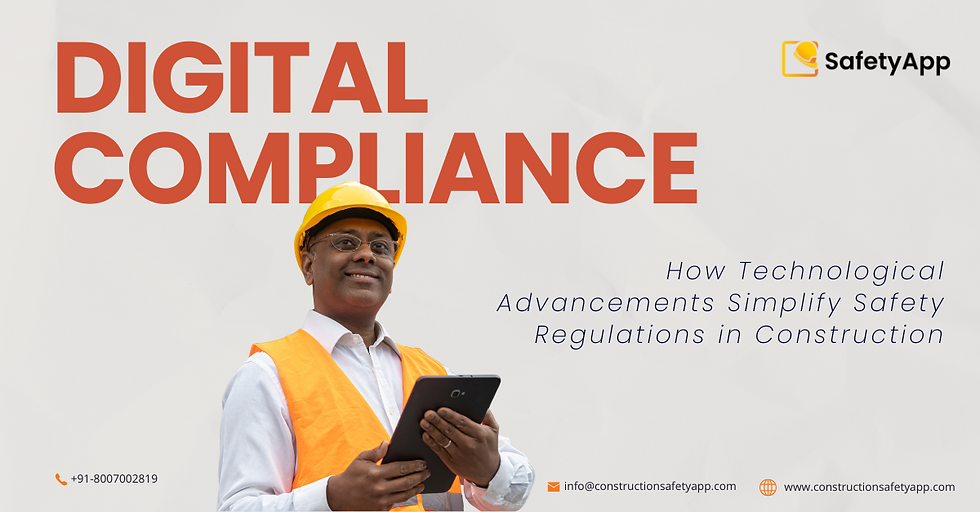Digital Compliance: How Technological Advancements Simplify Safety Regulations in Construction
- Harshali Deshmukh
- Apr 10
- 2 min read
Updated: Oct 6

Digital Compliance: How Technological Advancements Simplify Safety Regulations in Construction
The Compliance Challenge in Construction
Regulatory compliance has long been a double-edged sword in the construction industry. While safety laws and standards are essential to protecting workers, ensuring compliance has traditionally been a time-consuming, manual, and error-prone process.
From keeping up with changing regulations to maintaining proper documentation for audits, construction companies often find themselves buried under mountains of paperwork. And yet, non-compliance can result in heavy fines, project shutdowns, and worst of all, preventable accidents.
The solution? Technology-driven compliance systems that streamline documentation, automate reporting, and provide real-time insights to ensure every site meets safety standards effortlessly.
The Shift from Paper to Digital
Gone are the days when compliance meant stacks of paperwork, outdated spreadsheets, and last-minute rushes to gather safety reports. Digital solutions are transforming compliance into an automated, data-driven process, ensuring that safety isn’t just a requirement—it’s a seamless part of daily operations.
Here’s how technological advancements are making compliance simpler than ever:
1. Real-Time Data Tracking
Modern compliance platforms integrate with IoT devices, wearables, and mobile apps to provide real-time monitoring of safety conditions. Instead of waiting for monthly safety audits, supervisors get instant updates on potential risks—allowing them to take immediate action.
2. Automated Reporting & Documentation
Instead of manually logging inspections, technology allows workers to capture, store, and access compliance data on the go. With cloud-based solutions, safety reports, checklists, and incident logs are securely stored and easily retrievable—making audits stress-free.
3. Digital Checklists & Inspections
AI-powered systems can generate smart checklists based on project type, site conditions, and regional regulations. This means no more relying on outdated forms—every checklist is customized to ensure full compliance with the latest safety laws.
4. Training & Certification Management
One of the biggest compliance gaps in construction is worker training. Digital platforms now help track certifications, schedule refresher courses, and alert management when a worker’s safety training is due for renewal—ensuring that only qualified personnel handle critical tasks.
5. Instant Incident Reporting
When an incident occurs, timely reporting is crucial. Digital systems allow workers to instantly log safety concerns via mobile apps, complete with photos, videos, and location tracking. This ensures a transparent, documented process that improves accountability and prevents future incidents.
Enhancing Regulatory Compliance in Construction
Regulatory compliance in construction is no longer merely about playing catch-up with evolving laws and regulations. Instead, advancements in technology are transforming the process into one that is proactive, efficient, and effortless. By leveraging innovative tools, construction firms can anticipate changes, streamline compliance efforts, and significantly reduce the risk of costly penalties.
Companies that adopt automated compliance systems are not just avoiding fines and legal troubles—they’re building safer, more efficient workplaces. They are shifting from a mindset of "checking boxes" to one of continuous safety improvement.
The question is no longer whether compliance is necessary—it is. The real question is:
Are we ready to let technology make compliance work for us, instead of against us?


